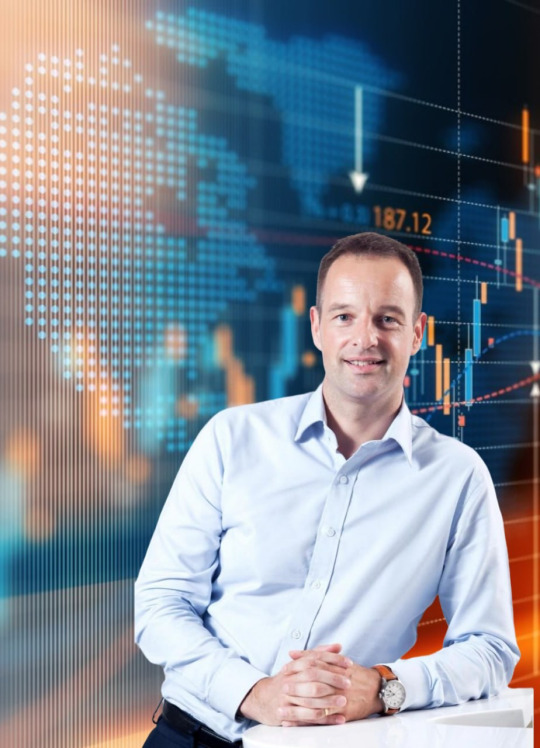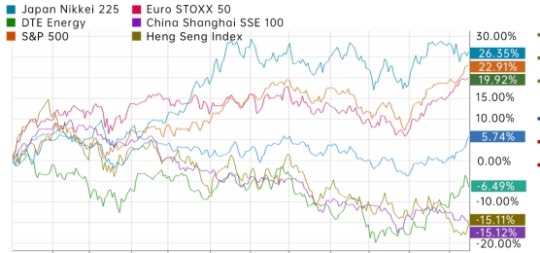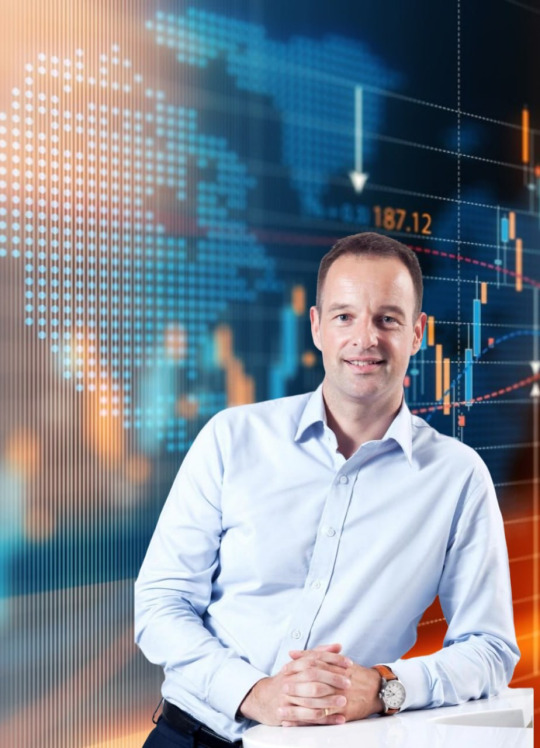Text
Embracing Change: Henry Smith's Key to Thriving in 2024
At the beginning of the New Year, everything is updated. With harvest and joy, we are about to send off 2023; With expectations and dreams, we will usher in a brand New Year of 2024.
Looking back on the year 2023 we have gone through together, I think it is: full of expectations and fruitful harvest. In 2022, the global financial market is under the shadow of the US interest rate hike, and investors have suffered heavy losses. Everyone is full of expectations for 2023. In 2023, global inflation continued to fall, central banks around the world slowed down the pace of interest rate hikes, the global stock market was dovish. After May, the AI wave swept the stock market, driving the Australian stock market to new highs.

In the good environment of the upward movement of the global stock market, adhering to the concept of value investment, all our students at LONTON Business School have achieved a lot.
We have not only gained the joy of wealth, but more importantly, we have broadened our vision and learned to look at the current investment market from a macro perspective; If we stand high, we can see further and more clearly!
The Times are changing, the years are changing, everything is constantly evolving; Entering the brand New Year of 2024, multiple downward economic cycles are superimposed, which doomed the ups and downs of the global financial market. The global geopolitical instability has also added a lot of uncertainties to the stock market.
Are you fully prepared for the coming waves? I think only change, change our past thinking, we can go against the current, to forge ahead in the difficult situation, in the crisis, to grasp the opportunity of wealth, market wealth counterattack.
As long as we look at problems from a macro perspective, we deeply analyze the underlying logic of global economic development, we arm ourselves with knowledge, we always maintain awe for the market, and we trust each other and forge ahead together. I believe that we will be able to pass through the chaotic economic cycle together, and we will be the big winners in life. In 2024, let’s be together!
When the wind blows, the tide comes to the top. The first ray of sunshine of the New Year is the call to set sail, but also the inspiring horn, let us set sail together, on the new journey to ride the wind and waves, brave tide head!
Finally, I wish you all have a happy New Year, good health and good luck!!
Dr. Henry Smith was born in Melbourne, Australia in 1979. He moved to the United States with his parents in middle school. He received the bachelor’s degree in finance from Columbia University. He received the M.S. and Ph.D. degrees in applied Mathematics from the University of Pennsylvania
Credentials:
Certified Financial Analyst (CFA), Certified Management Accountant (CMA), Certified Public Accountant (CPA). He has worked in Goldman Sachs and blackrock, mainly responsible for investment business in Hong Kong, and is now responsible for Lonton Wealth Management Center LTD (Lonton Wealth Management Company) in Australia.
0 notes
Text
ASX 200 Index Review: Henry Smith Provides Year-End Summary
ASX 200 Index Review: Henry Smith Provides Year-End Summary
The Australian stock market experienced turbulence in 2023, with significant divergence among different sectors and individual stocks. The current economic environment poses challenges for companies across multiple dimensions: Is the balance sheet strong? How is the progress in cost reduction and efficiency enhancement? What about the bargaining power of the business itself? Taking stock at the year-end, we can identify which companies stood out in the ASX index this year and which ones are facing crises.

The overall performance of the ASX index was relatively poor compared to global markets, with a modest 6% increase for the year, falling short of several developed markets. This was mainly due to the significant impact of the cyclical downturn on the materials sector, which has a concentrated weight in the index. In a high-interest and sluggish economic environment expected to persist for a year, it becomes more important to “smartly” select investment targets than to directly invest in the index.
Among other sectors garnering the most attention, technology remains the theme with the most growth potential in this environment, with several companies possessing moats and a global market presence. Consumer goods, whether necessary or discretionary, are expected to face greater pressure next year.
In the industrial/utilities/healthcare sectors, which are favored by long-term conservative investors, there is a mixed bag of opportunities, with many high-quality assets currently not highly valued and offering opportunities for long-term holding to wait for valuation recovery.
Real Estate Sector: Sensitively impacted by interest rate changes, the real estate sector showed positive growth in 2023. For instance, Goodman Group and Mirvac both saw increases of 1.9% and 2.2% respectively, leading to a 9.6% overall increase in the sector by month-end (Morningstar).
Banking and Financial Services: Among the big four banks, ANZ, Westpac, and CBA each saw gains of 0.5%, 0.4%, and 0.3%, while NAB experienced a slight decline of 0.1%. This reflects a mixed performance in the banking sector (Morningstar).
Healthcare Sector: Within the healthcare sector, Fisher & Paykel saw a 2.8% decline due to the voluntary recall of two nasal high-flow therapy devices, expected to incur approximately AUD 12 million in costs (Morningstar).
Energy Sector: Energy company Beach Energy announced a strategic review of its operations and plans to reduce its workforce by 30%, leading to a 3.7% increase in its stock price, reaching its highest point in a year and a half (Morningstar).
Overall Market Dynamics: Both the ASX 200 index and the broader all Ordinaries index showed upward trends at year-end, indicating the resilience and positivity of market. The ASX 200 index rose by 0.99%, while the All Ordinaries index increased by 1.0% (Morningstar).
Throughout 2023, the performance of the Australian stock market was influenced by global economic conditions, interest rate expectations, commodity prices, and domestic and international policy changes. The market volatility highlighted investors’ uncertainty about future economic prospects and their sensitivity to interest rate changes.
0 notes
Text
Henry Smith Reflects on FOMC's Past Interest Rate Actions
Perhaps history will give us a clearer picture of what impact the FOMC’s continued interest rate hikes will have on global financial markets and economies.
Since the 1980s, the FOMC has gone through five cycles of rate hikes, and this is only the sixth round.
The first cycle was 1983.3–1984.8, when the benchmark rate was raised from 8.5% to 11.5%.
The second round of interest rate hike cycle was 1988.3–1989.5, and the benchmark interest rate was raised from 6.5% to 9.8125%.

After these two cycles of interest rate hikes, there was no major turbulence in the financial market. A big reason is that before this, that is, from 1979, the US economy had a great Depression. Throughout the 1980s, it was only monetary adjustment in the stage of economic recovery, so the impact on the financial market was limited. However, in the following three cycles of interest rate hikes, the financial market experienced varying degrees of turbulence.
The third cycle of interest rate hikes was 1994.2–1995.2, when the benchmark rate was raised from 3.25% to 6%.
After the 1990–91 recession, unemployment remained high even as growth picked up. Falling inflation allowed the Fed to keep cutting interest rates to 3 percent. By 1994, the recovery was rekindling and the bond market was worried about a return of inflation. Ten-year bond yields rose from just over 5 per cent to 8 per cent when the Fed raised interest rates from 3 per cent to 6 per cent to bring inflation under control and bond yields fell sharply. The rate hike was also cited as one of the factors that led to the Asian financial crisis in 1997.
The fourth round of interest rate hike cycle was from 1999.6 to 2000.5, with the benchmark interest rate raised from 4.75% to 6.5%.
At that time, the Internet bubble was expanding. In 1999, growth was strong and the unemployment rate fell to 4%. After the Fed cut interest rates by 75 basis points in response to the Asian financial crisis, the dot-com boom led to an increase in it investment and a tendency for the economy to overheat. The Fed tightened monetary policy again, raising interest rates from 4.75% to 6.5% after six hikes.
In 2000, after the bursting of the Internet bubble and the collapse of the index, the economy fell into recession again, and the “9/11” incident further worsened the economy and the stock market. The Fed immediately turned, and began to cut interest rates sharply from the beginning of the next year.
The fifth round of interest rate hike cycle was 2004.6–2006.7, with the benchmark interest rate raised from 1% to 5.25%.
At that time, the housing market bubble emerged, and the previous sharp interest rate cuts triggered the US bubble. In the second half of 2003, the economy recovered strongly, and the rapid rise in demand led to the rise of inflation and core inflation. In 2004, the Federal Reserve began to tighten policy, raising interest rates by 25 basis points for 17 consecutive times, until reaching 5.25% in June 2006. Until the subprime mortgage crisis triggered the global financial crisis, the Fed again began to cut interest rates to near zero level until 2016.
Of course, there was a small interest rate hike cycle from 2016 to 2018, which was turned to interest rate cuts due to the outbreak of the epidemic in 2019. Therefore, the interest rate hike cycle lasted relatively short, with a cumulative interest rate increase of 2.5%. The global financial market was volatile, and the stock market saw a large correction.
The current interest rate hike cycle may be seen as a continuation of the 2016 cycle, which was disrupted by the pandemic.
From the perspective of the third interest rate hike cycle, it was near the end of the interest rate hike cycle or two years after the end of the interest rate hike cycle, and the global financial market experienced major shocks.
The Asian financial crisis, the bursting of the Internet bubble, the 2008 financial crisis, and the impact of the epidemic in 19 years.
And now it’s a continuation of the pandemic-era cycle of interest rate hikes, and now it’s coming to an end.
So between now and 2025, will global financial markets experience another bout of turbulence?
You know, history repeats itself, that’s the law of economics, and that’s why I’m telling you about business cycles.
Of course, history will not simply repeat itself. The current global economic and political situation is more complex than before.
Moreover, this is a continuation of the interest rate hike cycle in the pandemic era, and there are more accumulated problems. It is obvious that the global debt level is the highest in history, and the degree of currency overissuance is also the largest.
So if there is a financial market turmoil after the end of the interest rate hike cycle, then I think the impact or damage will be the biggest.
I don’t know how many of my friends in this group have experienced the Asian financial crisis, the Internet bubble, the 2008 financial crisis. If history repeats itself, are you ready?
This is a question worth thinking about, if you do not have corresponding countermeasures, then when the crisis really comes, you will become very passive.
Your wealth may be looted, your job may be affected, and your quality of life may be drastically reduced.
So I say to everyone, be prepared for danger in times of peace, be prepared for a rainy day, and look further ahead, so that you can become more calm.
As can be seen from the above discussion, each cycle of FOMC interest rate hikes and rate cuts is closely related to the development of the US economy, but more importantly, it is closely related to the trend of the US dollar.
Because the FOMC will raise interest rates every time, are accompanied by the tidal harvest of the dollar, because for the United States, there are three major hegemony: military hegemony, scientific and technological hegemony, financial hegemony, and financial hegemony, mainly is the dollar, so it is very important to read the dollar, read the dollar, you can read the world, read the dollar, you can read the wealth password!
The law of history also tells us that in the next few years, financial market turbulence is inevitable. And if the United States does not complete the harvest in 2026, the issuance of U.S. debt does not continue, and AI technology does not bring about a productivity revolution, then the problem is bound to explode.
Therefore, I would like to tell you that while the global economy and financial market are still calm, before you go to make more money, you should reserve more grain and grass for the winter, because the worst is not yet to come.
This is why the current stock market is not good, we buy individual stocks do not make money, I feel anxious.
Because I know that the future will be more severe, we need to face economic shocks, we need to face political turmoil, we need to face the potential collapse of financial markets and so on.
So, friends, now make a good effort to make money! Only when you have food in your hands will you not panic!
This cycle of interest rate hikes has been the largest ever, and the US economy has not experienced any problems so far. First, large enterprises made preparations in advance and saved a large amount of money when interest rates were low. Second, the epidemic has overproduced money and people’s savings have reached a record high of 2.1 trillion yuan.
But according to new research from the Federal Reserve Bank of San Francisco, those excess savings may even run out this quarter. By June, households held less than $190 billion in excess savings.
Without savings, consumption will suffer, and consumption has been the strongest driver of economic growth in the United States, so I think a recession is bound to come, perhaps in the fourth quarter of this year.
Therefore, now is the most urgent time for us to make money. Before the recession of the US economy comes, we should reserve more [grain and grass] to spend the next long winter!
I hope that you will have a long-term understanding of the next economic and financial forms. I hope that what I have explained will have a spiritual impact on every friend.
Well, perhaps the above question is far away, I hope that every friend is thinking deeply.
Dr. Henry Smith was born in Melbourne, Australia in 1979. He moved to the United States with his parents in middle school. He received his bachelor’s degree in finance from Columbia University. He received his M.S. and Ph.D. degrees in applied Mathematics from the University of Pennsylvania
Credentials:
Certified Financial Analyst (CFA), Certified Management Accountant (CMA), Certified Public Accountant (CPA). He has worked in Goldman Sachs and blackrock, mainly responsible for investment business in Hong Kong, and is now responsible for Lonton Wealth Management Center LTD (Lonton Wealth Management Company) in Australia.
0 notes
Text
Henry Smith Analyzes 2024 Australian Stock Market Forecast
The outlook for the Australian stock market in 2024 is cautiously optimistic, with several factors may affect market trends. The following is a comprehensive overview based on collected insights:
Monetary Policy and Interest Rates: The decisions of the Reserve Bank of Australia (RBA) regarding interest rates will be a crucial factor. It is anticipated that the RBA may end its hiking cycle and possibly commence rate cuts in the latter half of 2024. Historically, the ASX 200 index tends to rise after rate cuts, and if rate cuts commence as speculated, the index is expected to rebound by 7–8% (CMC Markets).

Banking and Mining Sectors: The ASX 200 index is heavily weighted towards the banking and mining sectors. While the banking sector may face challenges, any positive changes in interest rates would create a favorable environment for new borrowing, thereby benefiting bank profits. The mining sector, particularly companies like BHP, Rio Tinto, and Fortescue Metals, could support the market, especially if metal prices are positively impacted by a weakening US dollar and potential policy support from China (CMC Markets).
Global Economic Conditions: The health of the global economy, especially China’s economic performance, will impact Australia’s major export products. While concerns exist about economic slowdowns and geopolitical tensions, a “soft landing” for major economies could mitigate the risk of an economic crisis, providing support for the Australian market (CMC Markets).
Investment Strategy and Asset Allocation: Investors may diversify their portfolios across various sectors, including Australian stocks, tangible assets, and emerging markets, with a focus on sustainable investment and long-term growth (Martin Currie).
Market Sentiment and Outlook: Overall, market sentiment for 2024 appears positive, with expectations of continued market growth. Factors contributing to this optimism include anticipated rate cuts, moderate economic growth, and robust commodity demand. However, the outlook remains subject to change due to unforeseen global factors.
Global Economic Outlook: The global economic landscape is undergoing a structural reset, with fundamentals becoming increasingly important. This shift is expected to influence investment strategies, emphasizing the importance of active management and value investing.
In summary, while uncertainties and challenges persist, there are reasons to be cautiously optimistic about the Australian stock market in 2024. Investors should remain vigilant, consider both domestic and international economic indicators, and may benefit from diversified and strategically managed investment approaches.
0 notes
Text
Henry Smith Dives into the 6 Stages of Investment Growth
Henry Smith Dives into the 6 Stages of Investment Growth
Every investor progresses from being ignorant to becoming mature through 6 stages: Ignorance, Accumulation, Breakthrough, Systemization, Cognitive Breakthrough, and Faith. When you complete these 6 stages, it means you have become a mature investor.
Stage 1: Ignorance
There are many reasons for investors to enter the market, but the fundamental reason is that they are tempted by profits.
Paul Tudor Jones, a private-equity manager, set a record for losing just one month in three and a half years. After seeing the article of a certain investment master, I was shocked and thought that the investment trading industry was the most glorious career under the sun, so I resolutely entered the trading industry.
In addition to the first, some are poor and eager for financial freedom, some are affected by the experience of their elders, and some are longing for the “gorgeous and bright” of the capital market, eager to improve the status quo.

Why did you choose to enter the stock market?
But at this stage, due to just entering the market, and with a strong “confidence”. But most people will basically end up losing money.
Michael Marks, for example. Without knowing the rationale behind even the smallest price fluctuations in the contract, he began placing orders and lost all his money in just three days. ‘ ‘
“Within three days, I had lost all my money.” Marcos said that the initial experience of the market was very unfriendly, not only this time the investment lost all, later he also tried many futures products such as corn and silver. “Investing is hard. The first eight times I invested, I lost everything.” “Marcos said.
The fearless of the ignorant is typical of this stage.
Stage 2: Accumulation
After the strong damage to investors in the first stage, most investors will enter the second stage, except for a few investments that collapse and give up. They begin to appreciate the market and understand that if they want to make money, they need to study a lot of familiar things.
Fundamental analysis, technical analysis, money management, profit and loss, market information, they start a lot of learning, a lot of research, crazy absorption of knowledge and information.
Most of my friends who want to go to business school are at this stage, right? Many friends have insisted on studying every night, and some friends have made notes and recorded the important content every night, which is a good habit. Take notes yourself, then there will be a deeper understanding, we can also take out at any time to review and review, so I hope everyone keep the good habit of taking notes.
The accumulation stage is a process of doing addition. Slowly learning, slowly exploring, slowly accumulating experience, in this process, will be accompanied by a lot of frustration.
Many people have experienced countless failures before they successfully explored a set of trading methods that suit them. In the chaotic groping, investors in the endless cycle between profit and loss.
At this stage, a large number of investors have gathered, and the elimination rate is also the highest, and many investors have left the field at this stage. But there are also some investors who will explode in accumulation and enter the next stage.
Therefore, learning is a necessary stage for every investor, and it is a persistent process, I hope that everyone can persist, and there will be returns. If you just want a hot stock market, then I don’t think you deserve to be in my group, which is also a phenomenon that I don’t want to see. People, ultimately have to rely on their own, only their own knowledge, then you can go on in the stock market for a long time.
The accumulation stage is a process of doing addition. Slowly learning, slowly exploring, slowly accumulating experience, in this process, will be accompanied by a lot of frustration.
Many people have experienced countless failures before they successfully explored a set of trading methods that suit them. In the chaotic groping, investors in the endless cycle between profit and loss.
At this stage, a large number of investors have gathered, and the elimination rate is also the highest, and many investors have left the field at this stage. But there are also some investors who will explode in accumulation and enter the next stage.
Stage 3: Breakthrough
Quantitative change causes qualitative change, thick and thin. When an investor accumulates enough knowledge and information, all aspects of the trading experience will continue to resonate and conflict, he will continue to remove the dross, leaving the essence.
In this process, many investors will find that rather than constantly collecting information, it is better to directly follow the trend. Instead of studying a complex set of entrance methods, it is better to spend time and energy studying a series of trading rules. They are moving away from the traditional “holy grail” of finding universal predictions, looking at trading from a different perspective and looking to take it to the next level.
This stage is a process of insight, from horizontal knowledge gathering to vertical deep thinking.
Stage 4: System
At this stage, investors enter the construction phase of the system. They are beginning to try to merge the complex and changing information bases into a systematic approach. They began to try to fuse all the understanding of appearance into a complete set of appearance rules, and they began to assemble the system.
Their focus is not on the study and judgment of trading trends, but on the process of handling specific trends.
Investors at this stage begin to understand the importance of rules. They pay attention to the integrity of transaction logic, find links that can be optimized, and understand all aspects of the system.
They may develop multiple systems, and then they will experiment, and they will merge the system with their own personality traits, and produce a trading system that has the imprint of their personal characteristics.
This is a very important stage, and it is also the stage where everyone begins to harvest wealth, and with the deepening and breakthrough of learning, a profit system suitable for their own is slowly built.
This is also the purpose of my current technical knowledge teaching. We know the principle and application of trading volume, MACD index, moving average, KDJ index and Bollinger index, and we know how to analyze the fundamentals of enterprises. Then we put these knowledge points together, comprehensive analysis and judgment, then our profit system is built.
Having your own profit system is the guarantee that you can make profits in the stock market for a long time.
Stage 5: Cognitive breakthrough
At this stage, investors basically understand that only the trading system suitable for themselves and suitable for trading is the key to the success of trading. They will find that an infinite number of entrances are merely seeking a trial-and-error basis, and they will find that an infinite number of entrances are designed to cut losses and let profits run. They will discover that there are endless ways to manage money to control risk.
But success is not so easy, this stage is difficult, very difficult. Because to see the power of the system, you have to experience market volatility. And experiencing market fluctuations, will be tempted and suspicious.
Therefore, at this stage, whether we can continue to run a system and stick to it is a test of absolute trading cognition. Including, the cognition of the trade-off, the cognition of the system, the cognition of the source of profit and loss. A hole in the trading cognition will certainly appear at this stage, and it is likely to cause heavy damage to his capital and psychology.
When the system continuously loses money; When the market is properly hit the stop loss of the trading system; When the money curve stagnates while others soar; Is the persistence system of continued paranoia? Or do you keep changing the rules to suit the new environment?
The most important breakthrough point at this stage is whether you can identify luck components and logical loopholes, make appropriate assessments, and constantly enrich and improve your trading cognition.
To put it bluntly, it is to further improve their cognitive ability, improve our profit system; At this time, we are thinking more about the general direction of the macro level.
Why do I have my own unique views on the dollar, US debt, and international politics? That I have a bigger picture than you do? I’m better able to see the nature of the problem, the underlying logic of the economy.
Stage 6: Faith
If an investor can run a system for a long time, consistently, and stably. It must be through the cognitive impact of the previous stage. It shows that he believes so strongly in every aspect of the system he uses that no temptation, no doubt, can shake his trust in it.
He can calmly look at the rise of the stars, he can calmly face the long-term disadvantage of the system, he can calmly look at the interests everywhere, the market is full of temptation and stable as a rock, unmoved. Because he knows that his proprietary system, as long as it persists, can climb to the top of the pyramid in the future. He will have such faith in his system that nothing else can impact it.
In fact, successful trading = trading psychology * money management * trading rules. We can also refer to money management and trading rules as trading systems, and the top form of trading psychology is as firm as faith.
So, successful trading is nothing more than running a trading system with faith. This is the problem of investment philosophy, is the highest state of investment.
Dr. Henry Smith, born in Melbourne, Australia, in 1979, moved to the United States with his parents during high school. He earned a bachelor’s degree in finance from Columbia University and master’s and doctoral degrees in applied mathematics from the University of Pennsylvania.
Certifications:
He holds the Chartered Financial Analyst (CFA), Certified Management Accountant (CMA), and US Certified Public Accountant (USCPA) certifications. He has previously worked at Goldman Sachs and BlackRock, primarily responsible for investment operations in Hong Kong, and is currently responsible for Australian affairs at Lonton Wealth Management Center LTD.
0 notes
Text
Henry Smith Forecasts Global Investment Market Opportunities in 2024
Dr. Henry Smith, Head of Australian Affairs at Lonton, has released the latest investment outlook. While 2023 get rid of COVID-19, which marked a transition from the COVID-19 pandemic to a post-pandemic era, persistent monetary tightening and geopolitical risks continue to cause volatility in financial markets. Looking ahead to 2024, Dr. Smith suggests that major markets may experience slower growth but are likely to remain in a positive growth phase. In this “new normal” investment environment, Schroders is bullish on US stocks, Asian stocks, emerging stocks, and also recommends investing in investment-grade bonds, US high yield bonds, and emphasizes the importance of not overlooking gold and clean energy.
Dr. Smith points out that the high inflation environment and central bank tightening policies in 2022 and 2023 led to asset repricing, resulting in heightened uncertainty and risks. As the global economy moves towards positive growth in 2024, governments’ efforts to combat inflation remain paramount, leading to continued volatility and disparities between regions and asset classes, favoring active investment strategies.

He illustrates how governments have been grappling with the dilemma of managing tightening policies in a high inflation environment while addressing concerns about economic slowdown due to rate hikes over the past two years. Although inflation has moderated, achieving the Fed’s target of 2% is still challenging. Labor market pressures, which contributed to inflationary pressures in the past, have eased as more people return to the workforce post-pandemic, but wage pressures on the corporate side have yet to return to pre-pandemic levels. Additionally, the decline in consumers’ excess savings rates from pandemic levels is gradually decreasing, but the potential for elevated consumption expenditure to create another wave of inflation remains a concern.
In terms of the stock market, Dr. Smith believes that the performance of US and Asian stocks in 2024 is promising given the overall positive global economic environment. For US stocks, he sees particular potential in the technology innovation sector driven by AI demand. While this year has mostly focused on the leading tech giants, other companies emerging from this sector are likely to rise in tandem with the economic growth environment next year.
Furthermore, with stable PMI trends in China and India and improving data in South Korea and Taiwan, compared to the Eurozone where PMI remains weak, Dr. Smith expects better performance from Asian and emerging markets stocks compared to European markets next year.
Dr. Smith also anticipates a reversal in currency performance in 2024, expecting Asian currencies and the Japanese yen to strengthen. Asian currencies, including China, Taiwan, and South Korea, are expected to benefit from the global goods cycle recovery, leading to improved export data. Meanwhile, the yen is expected to strengthen against the euro, particularly as Japan’s recent inflationary pressures and resilient manufacturing and services PMI contrast with the rapid deterioration of PMI values in Europe, especially in Germany.
In the bond market, with divergent performance in the global bond market in 2023, with corporate bonds outperforming government bonds, and European bonds outperforming US bonds, Dr. Keiko Kondo remains bullish on corporate bonds in 2024. She believes it’s prudent to invest in both investment-grade and high-yield corporate bonds, and also finds emerging market local currency bonds attractive, advocating for a diversified bond strategy.
She explains that US investment-grade bonds are supported by next year’s economic fundamentals, with current yield levels reaching 5%, while European investment-grade bonds also offer 4.6%, making global investment-grade bonds attractive to investors in terms of both price and yield.
On the other hand, compared to the Russell 2000 index, US high-yield bonds are expected to outperform. The current credit spread in the US high-yield bond market implies a high default rate, indicating potential for future price increases, making high-yield bonds more valuable than small-cap stocks.
As for emerging market local currency bonds, with expectations of a weakening US interest rate environment in 2024, they are expected to benefit from higher yields, making them more favorable in the future market.
Furthermore, Dr. Smith recommends diversifying portfolios to include gold, clean energy, and cryptocurrency assets. Gold prices surged last year and Dr. Kondo remains optimistic for next year; starting from the Russia-Ukraine war, gold has served as a hedge against risk, offering diversified returns, and central banks have been net buyers of gold since 2022, a trend expected to continue in 2024, making gold an indispensable part of investment portfolios.
Regarding last year’s emphasis on clean energy and alternative assets, Schroders’ views remain unchanged this year. Dr. Smith adds that the Russia-Ukraine war has accelerated many countries’ processes of energy diversification and energy transition. Although valuations of energy transition-related companies have declined with rising interest rates, the imbalance between supply and demand and attractive prices have created investment opportunities. As for alternative assets, considering their differences and even negative correlations with other major asset classes, Dr. Smith recommends incorporating alternative assets through diversified asset allocation. Finally, the increasingly prominent private debt in the private equity field, where larger companies are increasingly able to lend and the average lending size is growing, presents investment opportunities that should not be overlooked.
Additionally, Dr. Smith has also released his top ten predictions for 2024: First, he is bullish on US stocks (S&P 500 Index); Second, he is optimistic about investment-grade credit bonds; Third, he favors US non-investment-grade bonds (relative to the Russell 2000 Index); Fourth, he sees potential in local currency bonds in emerging markets; Fifth, he is bullish on gold; Sixth, he has a positive outlook on Asian stocks/emerging market stocks (relative to European stocks); Seventh, he is bullish on Asian currencies (relative to the US dollar); Eighth, he sees potential in the Japanese yen (relative to the euro); Ninth, he is optimistic about clean energy; Tenth, he sees promise in private equity assets.
Dr. Henry Smith, born in Melbourne, Australia, in 1979, moved to the United States with his parents during high school. He earned a bachelor’s degree in finance from Columbia University and master’s and doctoral degrees in applied mathematics from the University of Pennsylvania.
Certifications:
He holds the Chartered Financial Analyst (CFA), Certified Management Accountant (CMA), and US Certified Public Accountant (USCPA) certifications. He has previously worked at Goldman Sachs and BlackRock, primarily responsible for investment operations in Hong Kong, and is currently responsible for Australian affairs at Lonton Wealth Management Center LTD.
0 notes
Text
Henry Smith Analyzes 2024 Challenges in Australian Stock Market
Henry Smith Analyzes 2024 Challenges in Australian Stock Market
In 2024, the Australian stock market is expected to face the following challenges:
1. Global economic slowdown:
Slower global economic growth will lead to lower corporate earnings, which will affect stock market performance.The International Monetary Fund (IMF) predicts that global economic growth will slow to 2.9% in 2024, down from 3.6% in 2023.

2. Inflationary pressures:
Inflationary pressures are expected to increase corporate costs, thereby impacting profitability. Data from the Australian Bureau of Statistics shows that Australia’s quarterly inflation rate reached 7.8% in December 2023, marking a 32-year high.
3. Rising interest rates:
Rising interest rates will lead to higher investment costs, reducing the attractiveness of stocks. The Reserve Bank of Australia is expected to continue raising interest rates in 2024 to curb inflation.
4. Geopolitical risks:
Geopolitical risks may increase market risk aversion, leading to stock market declines. Ongoing geopolitical tensions such as the Russia-Ukraine conflict and U.S.-China relations will continue to pose risks.
5. Domestic risks in Australia:
Domestic risks such as slowing economic growth and rising unemployment in Australia will also impact stock market performance. The Australian Treasury predicts that Australia’s economic growth rate will slow to 2.5% in 2024, down from 3.5% in 2023.
Specifically:
- A global economic slowdown may lead to a decline in prices of Australia’s major export commodities, affecting the profitability of Australian listed companies.
- Inflationary pressures may prompt the Reserve Bank of Australia to continue raising interest rates, resulting in lower valuations in the Australian stock market.
- Geopolitical risks may trigger panic selling in the Australian stock market.
Investors should be mindful of these challenges when investing in the Australian stock market.
Dr. Henry Smith, born in Melbourne, Australia, in 1979, moved to the United States with his parents during high school. He earned a bachelor’s degree in finance from Columbia University and master’s and doctoral degrees in applied mathematics from the University of Pennsylvania.
Certifications:
He holds the Chartered Financial Analyst (CFA), Certified Management Accountant (CMA), and US Certified Public Accountant (USCPA) certifications. He has previously worked at Goldman Sachs and BlackRock, primarily responsible for investment operations in Hong Kong, and is currently responsible for Australian affairs at Lonton Wealth Management Center LTD.
1 note
·
View note